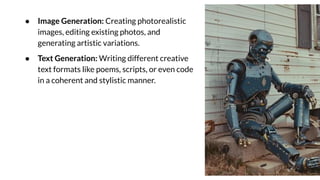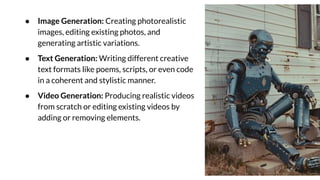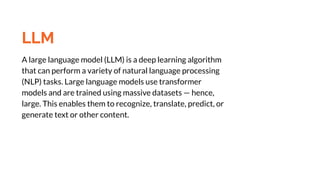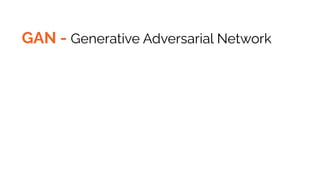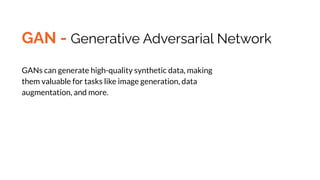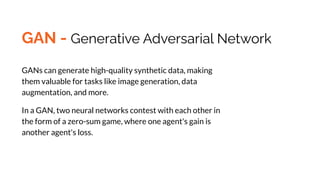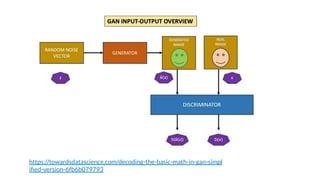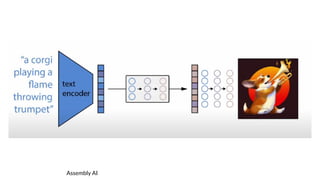Zilliz - Overview of Generative models in ML
- 1. Overview of Generative models in ML - Aishit Dharwal
- 4. Generative AI A branch of AI that focuses on creating new data. It utilizes machine learning algorithms to learn the underlying patterns and relationships within a dataset and then uses that knowledge to generate entirely new content that resembles the training data.
- 5. Generative AI A branch of AI that focuses on creating new data. It utilizes machine learning algorithms to learn the underlying patterns and relationships within a dataset and then uses that knowledge to generate entirely new content that resembles the training data.
- 6. ● Image Generation: Creating photorealistic images, editing existing photos, and generating artistic variations.
- 7. ● Image Generation: Creating photorealistic images, editing existing photos, and generating artistic variations. ● Text Generation: Writing different creative text formats like poems, scripts, or even code in a coherent and stylistic manner.
- 8. ● Image Generation: Creating photorealistic images, editing existing photos, and generating artistic variations. ● Text Generation: Writing different creative text formats like poems, scripts, or even code in a coherent and stylistic manner. ● Video Generation: Producing realistic videos from scratch or editing existing videos by adding or removing elements.
- 9. ● Image Generation: Creating photorealistic images, editing existing photos, and generating artistic variations. ● Text Generation: Writing different creative text formats like poems, scripts, or even code in a coherent and stylistic manner. ● Video Generation: Producing realistic videos from scratch or editing existing videos by adding or removing elements. ● Music Generation: Composing novel musical pieces in various styles.
- 10. Oreilly Media
- 11. LLM
- 12. LLM A large language model (LLM) is a deep learning algorithm that can perform a variety of natural language processing (NLP) tasks. Large language models use transformer models and are trained using massive datasets — hence, large. This enables them to recognize, translate, predict, or generate text or other content.
- 13. LLM A large language model (LLM) is a deep learning algorithm that can perform a variety of natural language processing (NLP) tasks. Large language models use transformer models and are trained using massive datasets — hence, large. This enables them to recognize, translate, predict, or generate text or other content. GPT 4 is one of the most versatile LLMs. It is multimodal - vision and text - can write code as well
- 14. https://www.linkedin.com/pulse/demystifying-llms-quick-summary-andrej-karpat hys-intro-lye-jia-jun-r70jc/ Next word prediction task forces the model to learn a lot about the world.
- 16. GAN - Generative Adversarial Network
- 17. GAN - Generative Adversarial Network GANs can generate high-quality synthetic data, making them valuable for tasks like image generation, data augmentation, and more.
- 18. GAN - Generative Adversarial Network GANs can generate high-quality synthetic data, making them valuable for tasks like image generation, data augmentation, and more. In a GAN, two neural networks contest with each other in the form of a zero-sum game, where one agent's gain is another agent's loss.
- 22. Diffusion Models
- 23. Diffusion Models Diffusion models are generative models that can create new data samples by starting with basic data and gradually transforming it into more complex and realistic data. Used for tasks like image generation, data denoising, and probabilistic data generation.
- 24. Diffusion Models Diffusion models are generative models that can create new data samples by starting with basic data and gradually transforming it into more complex and realistic data. Used for tasks like image generation, data denoising, and probabilistic data generation. Inspired by non-equilibrium thermodynamics: Add randomness and reverse it successfully! Add noise to original image and learn how to reverse the process.
- 25. Diffusion Models Diffusion models are generative models that can create new data samples by starting with basic data and gradually transforming it into more complex and realistic data. Used for tasks like image generation, data denoising, and probabilistic data generation. Inspired by non-equilibrium thermodynamics: Add randomness and reverse it successfully! Add noise to original image and learn how to reverse the process. 1. Stable Diffusion - uses latent diffusion model 2. DALL-E
- 28. Multimodal Models A Multimodal Generative model draws outputs from a combination of multiple data types to provide responses as insights, content, and more. Capable of processing information from different modalities, including images, videos, and text.
- 29. Assembly AI
- 30. Assembly AI
- 31. Assembly AI
- 32. Feel free to send in your questions in the comments/DM on Linkedin







